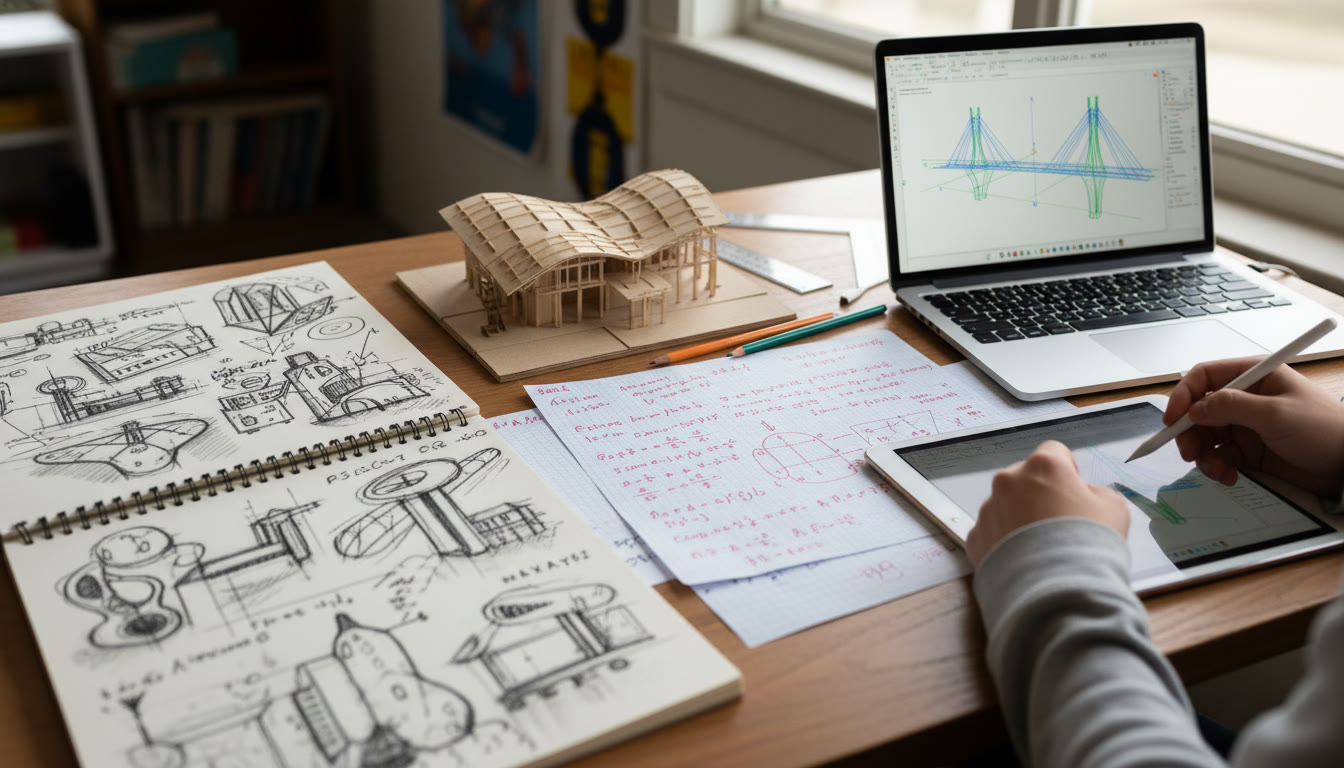Why AP Courses Matter for Aspiring Architects
If you dream of designing spaces — from cozy homes to daring civic buildings — your high school choices can tilt the scales in your favor. Architecture sits at the crossroads of art, engineering, and human behavior, and colleges look for applicants who can prove both creative vision and technical reasoning. That’s why combining AP Calculus and AP Physics with AP Art Foundations (or AP Studio Art) is a powerful, strategic trifecta.

What Admissions Committees Want
Most architecture programs want to see three things: a strong academic record in math and science, a reliable demonstration of visual and conceptual skills, and evidence of sustained creative practice. AP Calculus and AP Physics signal that you can handle quantitative problem solving. AP Art Foundations (or AP Studio Art) shows you’re serious about craft, composition, and concept development. Together, these courses tell a story: you’re not just an imaginative drawer — you can calculate loads, think structurally, and translate ideas into buildable forms.
Choosing the Right AP Courses: How to Balance Rigor and Portfolio Time
It’s tempting to load your schedule with every AP available, but admissions officers prefer depth over indiscriminate breadth. For future architecture students, prioritize the following:
- AP Calculus AB/BC: Understanding calculus — derivatives, integrals, and the way quantities change — is essential for spatial reasoning and later engineering or structural courses.
- AP Physics 1/2 or AP Physics C: Physics teaches statics, forces, and energy. AP Physics C (with calculus) is ideal if you want a deeper technical foundation, but AP Physics 1 and 2 still provide useful mechanics and materials intuition.
- AP Art Foundations or AP Studio Art: Courses that foster sustained visual investigation and a polished portfolio. Studio courses emphasize process, experimentation, and thematic cohesion — all portfolio gold.
Supplement these with courses like AP Environmental Science (good for sustainable design concepts), AP Statistics (useful for research and urban analysis), or computer science if you’re interested in computational design.
How to Use Each AP Course to Strengthen Your Application and Portfolio
AP Calculus: From Slope to Surface
Calculus trains you to think about continuous change — exactly what you need when considering load paths, roof geometry, or parametric forms. More importantly for admissions, success in calculus demonstrates that you can handle college-level quantitative thinking.
- Project idea: Create a small study linking curved roof geometry to optimization — model a roof profile, compute areas and volumes, and present sketches showing how curvature affects interior space and daylight.
- Showcase: Include a one-page write-up in your portfolio that explains the math behind a design decision. Admissions love applicants who can communicate technical thinking concisely.
AP Physics: Understanding the World Your Designs Must Withstand
Physics is the bridge between a pretty sketch and a buildable structure. Fundamentals like statics, materials strength, and basic dynamics inform decisions about spans, cantilevers, and façades.
- Project idea: Build a simple physical model to test cantilever behavior or wind load on a façade, document the process with photos, diagrams, and a reflective artist’s statement.
- Showcase: Use lab notebooks or a polished research page in your portfolio to show experimental thinking — hypothesis, test, result, and how it influenced your design.
AP Art Foundations / AP Studio Art: Crafting a Compelling Visual Narrative
Your portfolio is the single most important factor for many architecture programs. AP Art Foundations trains you to control composition, tone, scale, materiality, and concept — the language of design.
- Project idea: Develop a series of observational drawings of built spaces, followed by conceptual iterations and a small model. Show progression, not just final polish.
- Showcase: Organize work around themes (e.g., light, material reuse, thresholds). Colleges respond best to coherent bodies of work that reveal curiosity and growth.
Weekly Study Plan: Balancing AP Content and Portfolio Production
Students often ask how to divide time between heavy AP study and the equally demanding portfolio work. Here’s a sustainable weekly framework you can adapt:
| Activity | Weekly Hours (Suggested) | Why It Matters |
|---|---|---|
| AP Calculus drills and problem sets | 4–6 | Build procedural fluency and application skills. |
| AP Physics labs and conceptual review | 3–5 | Reinforce physical intuition and experiment-based learning. |
| Studio time for portfolio pieces | 6–10 | Depth and repeat practice produce stronger bodies of work. |
| College/portfolio research and applications | 2–3 | Curating pages, writing statements, and tailoring submissions. |
| Rest, critique sessions, extracurriculars | 3–5 | Critique skills and mental health fuel long-term performance. |
This plan leans into the idea that the portfolio requires ongoing, repetitive craft work — short, focused studio sessions every other day beat marathon sessions the night before an application is due.
Study Techniques That Work: From Problem Sets to Material Experiments
Active Problems, Not Passive Reading
For Calculus and Physics, the single best habit is active practice. Do problems, check solutions, and when you get stuck, reverse engineer the solution until the reasoning clicks. Use past AP free-response questions to practice explanation as well as computation — many architecture programs prize clear written reasoning.
Studio Practice: Iteration Trumps One Perfect Piece
In art and design, quantity fuels quality. Make iterations, photograph them, and annotate what changed and why. A portfolio that shows three versions of a problem — observation, concept, refinement — tells a richer story than an isolated final image.
Cross-Pollinate: Use STEM to Inform Studio Work
Some of the most memorable portfolio pieces come from applying a technical insight to a design problem. For example, use lessons from physics to explore tensile structures, or calculus-inspired curves to design a staircase that feels inevitable and elegant. Briefly documenting this cross-disciplinary thinking in your portfolio project descriptions demonstrates intellectual curiosity and synthesis.
Portfolio Essentials: What to Include and How to Present It
Your portfolio should balance technical drawings, sketches, models, and reflective writing. Here’s a checklist that many reviewers will appreciate:
- 4–12 curated pieces showing range and depth.
- A cover page with contact info and a short artist’s statement (2–4 sentences).
- Process pages for at least half the pieces (sketches, studies, models, notes).
- One clear built or installed project if you have it (even a small community build or a furniture piece).
- Evidence of technical thinking: annotated diagrams, structural sketches, calculations or lab notes tied to a design decision.
Quality Over Quantity — But Keep Options Open
Some schools ask for up to 12 pieces, others want fewer. Prepare a core of 6–8 strong works and a few alternates you can swap in depending on the program’s instructions.
Application Essays and Statements: Tell the Story Behind the Work
A technical-sounding portfolio packed with calculations can still fall flat if the narrative is missing. Use short captions and one or two longer statements to explain motivations, research influence (e.g., how a physics experiment changed your design), and what you learned during the process. Admissions committees read these to see the student behind the pixels.
- Tip: Frame one essay around a project that combined calculus/physics insight with an artistic outcome. Describe the problem, the constraints, the experiment, and the final idea.
- Tip: Keep language clear and personal — avoid jargon unless you explain it briefly.
How Sparkl’s Personalized Tutoring Can Fit Naturally Into Your Plan
Preparing for APs and building a portfolio are both time-intensive and highly individualized tasks. Many students benefit from 1-on-1 guidance to set priorities, get targeted feedback, and stay accountable. For example, a tutor can:
- Tailor study plans for AP Calculus and AP Physics so you practice the right problems at the right time.
- Offer structured critiques on portfolio pieces and help you translate a lab result or a math insight into a compelling design narrative.
- Provide ongoing accountability and mock critiques to simulate college jury days.
When used as a complement to a student’s independent work, personalized tutoring (like Sparkl’s 1-on-1 plans) can accelerate learning and make the entire process less overwhelming — especially during senior-year crunch time.
Sample Project Roadmap: From Class Concept to Portfolio Page
Here’s a step-by-step example of a project that ties AP Calc + AP Physics + Studio art into a portfolio-ready page.
- Week 1: Identify a problem — e.g., design a small pedestrian canopy that maximizes daylight and minimizes material use. Sketch initial concepts.
- Week 2: Use calculus to model the canopy curve (optimize curvature for surface area vs. shading). Produce initial computational sketches.
- Week 3: Conduct simple physics tests (model wind and load with small-scale prototypes). Document results.
- Week 4: Build a refined model, produce high-quality photos, and create process pages showing sketches, calculations, and test results.
- Week 5: Write a 300–500 word reflective statement linking the math and physics to the aesthetic and programmatic choices. Add this to your portfolio page.
Common Mistakes and How to Avoid Them
- Overloading on APs without portfolio time: If your schedule leaves no time for art-making, consider delaying an AP and focusing on portfolio development instead.
- Presenting finished work without process: Always include process. Admissions want to see how you think.
- Using jargon without explanation: Name the technical idea, then explain it simply and show how it influenced the design.
- Waiting to seek critique: Invite feedback early. Iteration after critique is what produces strong work.
How to Showcase AP Scores and Course Rigor in Applications
AP scores can be a bonus, but they aren’t everything. If your AP scores in Calculus or Physics are strong, list them on applications or include a brief note in your resume. Equally important: mention honors or awards related to your studio work, competitions, or any built projects. In many cases, your portfolio will outweigh a single test score — but together they paint a fuller picture.
Final Thought: Building an Identity as a Designer Who Thinks Like an Engineer
Architecture is unique because it demands both precision and poetry. AP Calculus and AP Physics give you the precision; AP Art Foundations gives you the poetry. When you blend these intentionally — by documenting experiments, showing math-informed decisions, and curating a thoughtful, process-rich portfolio — you create a compelling narrative: you are a designer who can imagine and also deliver.
Quick Checklist Before Submission
- Do you have 6–12 curated pieces showing process and final work?
- Are at least half your projects supported by sketches, notes, or experiments?
- Does one or two pages demonstrate technical thinking drawn from Calculus or Physics?
- Have you had at least two critiques from teachers, mentors, or tutors?
- Is your artist’s statement concise, personal, and reflective?

Next Steps: Start Small, Iterate Often
If you’re just beginning, pick one small project that interests you and commit to documenting every step. Schedule a weekly block for studio time and two focused math/physics sessions. Seek feedback early and consider targeted 1-on-1 tutoring to guide you through sticky technical concepts or portfolio curation. With steady practice and intentional cross-disciplinary projects, you’ll not only be ready for AP exams — you’ll be prepared to tell a compelling story to the schools you apply to.
Parting Advice for Parents and Students
Parents: encourage curiosity and provide structured time for both AP study and creative exploration. Students: be patient with the process — architecture is a marathon of learning, prototyping, and reflection. Celebrate small wins: a solved physics problem that clarifies a design choice, or a model that makes your idea suddenly legible. Those moments are the building blocks of a memorable portfolio and a successful application.
Good luck — keep designing, keep calculating, and most importantly, keep making. Your future studio is waiting.




















No Comments
Leave a comment Cancel